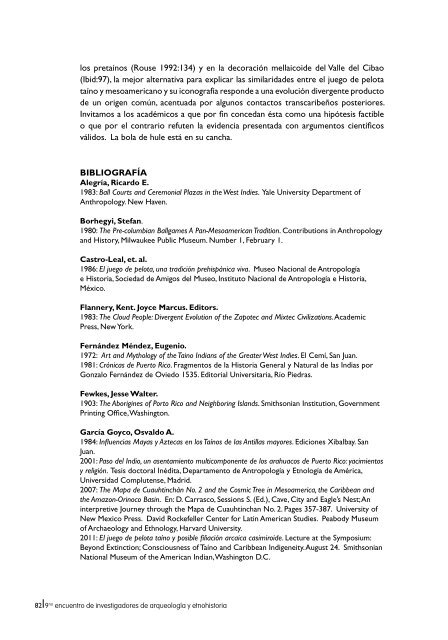9no Encuentro de Investigadores de Arqueologia y Etnohistoria
You also want an ePaper? Increase the reach of your titles
YUMPU automatically turns print PDFs into web optimized ePapers that Google loves.
los pretaínos (Rouse 1992:134) y en la <strong>de</strong>coración mellaicoi<strong>de</strong> <strong>de</strong>l Valle <strong>de</strong>l Cibao<br />
(Ibid:97), la mejor alternativa para explicar las similarida<strong>de</strong>s entre el juego <strong>de</strong> pelota<br />
taíno y mesoamericano y su iconografía respon<strong>de</strong> a una evolución divergente producto<br />
<strong>de</strong> un origen común, acentuada por algunos contactos transcaribeños posteriores.<br />
Invitamos a los académicos a que por fin concedan ésta como una hipótesis factible<br />
o que por el contrario refuten la evi<strong>de</strong>ncia presentada con argumentos científicos<br />
válidos. La bola <strong>de</strong> hule está en su cancha.<br />
BIBLIOGRAFÍA<br />
Alegría, Ricardo E.<br />
1983: Ball Courts and Ceremonial Plazas in the West Indies. Yale University Department of<br />
Anthropology. New Haven.<br />
Borhegyi, Stefan.<br />
1980: The Pre-columbian Ballgames A Pan-Mesoamerican Tradition. Contributions in Anthropology<br />
and History, Milwaukee Public Museum. Number 1, February 1.<br />
Castro-Leal, et. al.<br />
1986: El juego <strong>de</strong> pelota, una tradición prehispánica viva. Museo Nacional <strong>de</strong> Antropología<br />
e Historia, Sociedad <strong>de</strong> Amigos <strong>de</strong>l Museo, Instituto Nacional <strong>de</strong> Antropología e Historia,<br />
México.<br />
Flannery, Kent. Joyce Marcus. Editors.<br />
1983: The Cloud People: Divergent Evolution of the Zapotec and Mixtec Civilizations. Aca<strong>de</strong>mic<br />
Press, New York.<br />
Fernán<strong>de</strong>z Mén<strong>de</strong>z, Eugenio.<br />
1972: Art and Mythology of the Taino Indians of the Greater West Indies. El Cemí, San Juan.<br />
1981: Crónicas <strong>de</strong> Puerto Rico. Fragmentos <strong>de</strong> la Historia General y Natural <strong>de</strong> las Indias por<br />
Gonzalo Fernán<strong>de</strong>z <strong>de</strong> Oviedo 1535. Editorial Universitaria, Río Piedras.<br />
Fewkes, Jesse Walter.<br />
1903: The Aborigines of Porto Rico and Neighboring Islands. Smithsonian Institution, Government<br />
Printing Office, Washington.<br />
García Goyco, Osvaldo A.<br />
1984: Influencias Mayas y Aztecas en los Taínos <strong>de</strong> las Antillas mayores. Ediciones Xibalbay. San<br />
Juan.<br />
2001: Paso <strong>de</strong>l Indio, un asentamiento multicomponente <strong>de</strong> los arahuacos <strong>de</strong> Puerto Rico: yacimientos<br />
y religión. Tesis doctoral Inédita, Departamento <strong>de</strong> Antropología y Etnología <strong>de</strong> América,<br />
Universidad Complutense, Madrid.<br />
2007: The Mapa <strong>de</strong> Cuauhtinchán No. 2 and the Cosmic Tree in Mesoamerica, the Caribbean and<br />
the Amazon-Orinoco Basin. En: D. Carrasco, Sessions S. (Ed.), Cave, City and Eagle’s Nest; An<br />
interpretive Journey through the Mapa <strong>de</strong> Cuauhtinchan No. 2. Pages 357-387. University of<br />
New Mexico Press. David Rockefeller Center for Latin American Studies. Peabody Museum<br />
of Archaeology and Ethnology, Harvard University.<br />
2011: El juego <strong>de</strong> pelota taíno y posible filiación arcaica casimiroi<strong>de</strong>. Lecture at the Symposium:<br />
Beyond Extinction; Consciousness of Taíno and Caribbean Indigeneity. August 24. Smithsonian<br />
National Museum of the American Indian, Washington D.C.<br />
82 9 no encuentro <strong>de</strong> investigadores <strong>de</strong> arqueología y etnohistoria


















